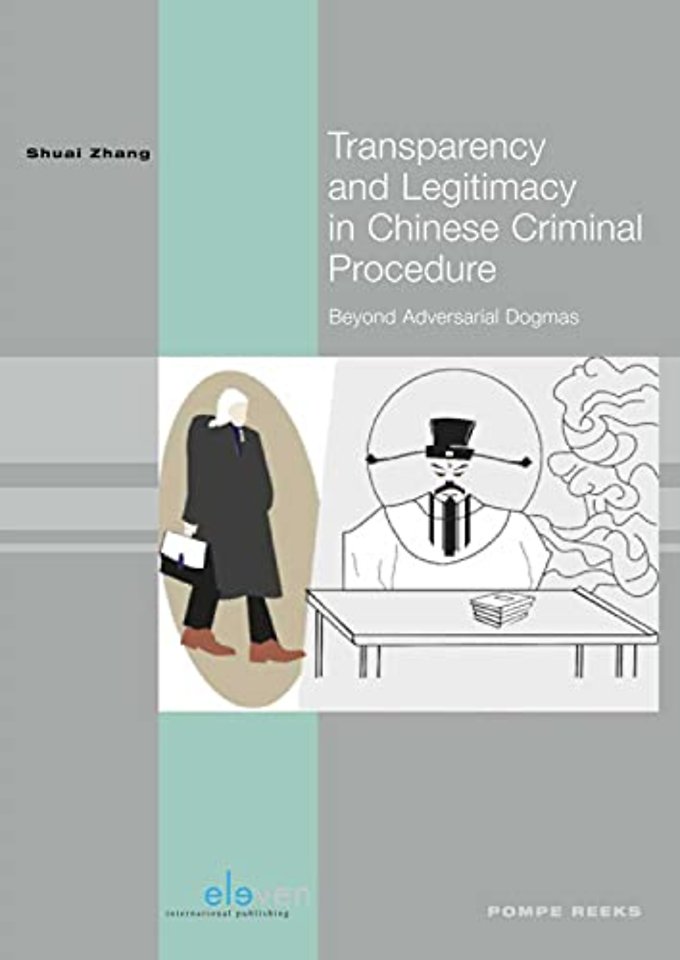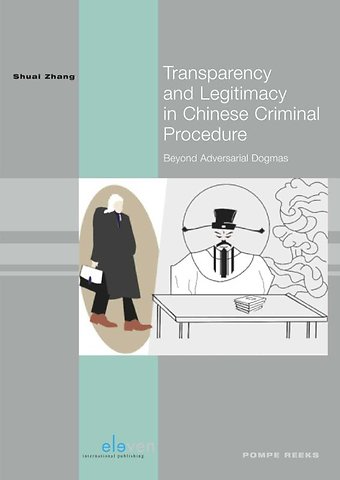Transparency and Legitimacy in Chinese Criminal Procedure
Beyond Adversarial Dogmas
Samenvatting
In recent years, the legitimacy of China’s criminal justice system has been increasingly challenged by the Chinese populace, in part due to the numerous exposed miscarriages of justice. The Chinese academic mainstream as well as the political and judicial authorities have looked towards the classical Anglo-American model of an adversarial criminal justice system to solve this problem. Reforms were subsequently introduced to add weight to court sessions and to provide external transparency of criminal trials, whilst curtailing the weight of pre-trial proceedings and the case file. Yet, these solutions have failed to restore the legitimacy of China’s criminal justice.
This book goes beyond adversarial dogmas and concentrates instead on internal transparency of criminal procedure, presupposing that in a criminal justice system such as that of China internal transparency of criminal procedure is a critical condition for external transparency and crucial to the achievement of legitimacy. The author proposes to nurture impartiality of public prosecutors and to emphasise internal transparency of criminal procedure. Prosecutorial control over the police and judicial checks on the procuratorates should be improved as well and active judicial investigation restored where necessary. External transparency, on the other hand, needs to be enhanced in a more cautious or internalized way.
Transparency and Legitimacy in Chinese Criminal Procedure is part of the Pompe series; publications that combine legal and social-scientific approaches to the problems of criminal law, written by staff members of the Willem Pompe Institute for Criminal Law and Criminology in Utrecht and by authors who share the Institute’s school of thought. Its central theme is the protection and enforcement of fundamental rights in a changing world, focussing on the position of vulnerable groups in relation to the state and on the significance of individual human rights in an international context.
Trefwoorden
Specificaties
Inhoudsopgave
Introduction 1
1 Interaction between legitimacy and transparency 1
2 Interaction between legitimacy and transparency in China 8
3 Research topic 10
3.1 Historical background of the research topic 10
3.2 Problem setting 17
3.3 Research questions 26
4 Methodology 27
4.1 Literature review and normative analysis 28
4.2 Theoretical review and check – scientific added value 29
4.3 Common case study 29
4.4 Comparative legal study 29
4.5 Analysis from a perspective of macro-history 31
Part I China’s status quo: Legitimacy in decline 33
Chapter 1
Basic tenets of China’s current criminal justice system 41
1.1 Introduction 41
1.2 The principles of Chinese criminal procedure 45
1.2.1 The independence of adjudicative and procuratorial powers 45
1.2.2 The check and balance principle 46
1.2.3 The ‘two-tier’ system of hearing 48
1.2.4 The presumption of innocence 51
1.3 The major actors involved in the Chinese criminal procedure 54
1.3.1 The public security organs 54
1.3.2 The people’s procuratorates 58
1.3.2.1 The development of the procuratorial system in China 60
1.3.2.2 The current position of the public procurators in different stages 65
1.3.2.3 The current prosecutorial system of China 68
1.3.2.4 The checks subject to procuratorates 70
1.3.3 The people’s court 71
1.3.4 The prison 71
1.3.5 The political-legal work committee 72
1.3.6 The defence 72
1.3.7 The victims 74
Chapter 2
Transparency of Chinese criminal procedure 75
2.1 The process of common criminal cases in China 80
2.1.1 Filing a case 80
2.1.1.1 Reporting and accepting a case 80
2.1.1.2 Preliminary investigation and decision of filing a case 83
2.1.2 Investigation 85
2.1.2.1 Summoning, custody and first interrogation 85
2.1.2.2 Formal pre-trial detention and ongoing interrogation and questioning 88
2.1.2.3 Conclusion of investigation and compilation of police dossier 89
2.1.3 The procuratorate proceedings 90
2.1.3.1 Review and approval of request for arrest 90
2.1.3.2 Review and initiation of public prosecution 91
2.1.4 Court proceedings 93
2.1.4.1 Pre-trial preparation 94
2.1.4.2 Court session 96
2.1.4.3 Judicial deliberation and decision 97
2.1.5 Execution 97
2.2 Internal transparency in common criminal cases 97
2.2.1 Police disclosure 98
2.2.2 Prosecution disclosure 109
2.2.2.1 The development of prosecution disclosure in China 109
2.2.2.2 The current mechanisms of prosecution disclosure 113
2.2.3 Defence disclosure 115
Interim conclusions of Part I 117
Part II Exemplary adversariaL systems 119
Chapter 3
Basic tenets of the ‘pure’ adversarial system 123
3.1 General: A common law tradition 123
3.2 Conceptual level 124
3.2.1 Epistemology and methodology 124
3.2.2 The outlook on justice 125
3.2.3 Community-based administration of justice 125
3.3 Institutional level 126
Chapter 4
Basic tenets and internal transparency of the English criminal procedure 131
4.1 The basic tenets of the English criminal procedure 131
4.1.1 The historical development of the modern English system 131
4.1.2 The current position of the public prosecutors in England 139
4.1.3 Checks and balances with regard to the CPS 143
4.2 Internal transparency of the English criminal procedure 146
4.2.1 Prosecution disclosure 146
4.2.2 Defence disclosure 149
4.3 Summary 150
4.3.1 The reasons that underlie England’s reform on disclosure 150
4.3.2 Primary conclusions 151
Chapter 5
Basic tenets and internal transparency of the Scottish criminal procedure 155
5.1 Basic tenets of the Scottish criminal procedure 155
5.1.1 The current function and position of Scottish prosecutors 156
5.1.2 The check and balance subject to the Scottish prosecution service 158
5.2 Internal transparency of the Scottish criminal procedure 160
5.2.1 Historical development of disclosure mechanism in Scotland 160
5.2.2 The state-of-the-art disclosure mechanism in Scotland 161
5.3 Summary 163
5.3.1 The reasons that underlie Scotland’s recent reform on disclosure 163
5.3.2 Primary conclusions 164
Chapter 6
Basic tenets and internal transparency of the US criminal procedure 167
6.1 Basic tenets of the US criminal procedure 168
6.1.1 Investigators 169
6.1.2 Prosecutors 170
6.1.3 The defence 172
6.1.4 The decider 174
6.2 Internal transparency of the US criminal procedure 174
6.2.1 Pre-trial discovery 175
6.2.1.1 Discovery by the defence 176
6.2.1.2 Discovery by the prosecution 178
6.2.1.3 Remedies and sanctions 180
6.2.2 The defence’s constitutionally guaranteed access to evidence 181
6.3 Summary 182
Chapter 7
Comparison between the adversarial systems 185
7.1 Basic tenets 185
7.1.1 Similarities 185
7.1.2 Differences 186
7.2 Internal transparency 187
7.2.1 Similarities 187
7.2.2 Differences 187
7.3 Summary 188
Interim conclusions of Part II 191
Part III China revisited and final conclusion 193
Chapter 8
China’s typical pattern of legitimate truth-finding and fair justice 195
8.1 The historical background of the Chinese legal system 195
8.1.1 The Feudal Era (21st century BC-221 BC) 196
8.1.2 The Imperial Era (221 BC-1911 AD) 203
8.1.2.1 The First Empire 204
8.1.2.2 The Second Empire 206
8.1.2.3 The Third Empire 206
8.2 China’s essential pattern of legitimacy building 209
8.2.1 The traditional pattern 209
8.2.2 The state of the art 215
8.3 The prospect of China’s essential pattern of legitimacy building 219
8.3.1 The impossibility to restore the traditional duality-patterned legitimacy 219
8.3.2 The possible way to reform the legitimacy building in China 222
Chapter 9
Final conclusion 223
9.1 Comparison between China and the adversarial systems 223
9.1.1 Basic tenets 225
9.1.2 Internal transparency 225
9.1.3 Summary 226
9.2 Possible solutions in the future 228
9.2.1 The pitfalls in the current system and sensible orientation of the solution 228
9.2.2 A desirable normative solution 234
9.2.2.1 About the basic tenets 234
9.2.2.2 About internal and external transparency 235
9.3 The feasibility and pitfalls of the proposed solutions 236
Contents xxv
Summary 241
Samenvatting 245
摘要 249
References 251
Annex I Samples of relevant case file instruments in China 263
Annex II Relevant legal provisions mentioned 275
Annex III Statistics 277
Curriculum Vitae 283
Anderen die dit boek kochten, kochten ook
Rubrieken
- cadeauboeken
- computer en informatica
- economie
- filosofie
- flora en fauna
- geneeskunde
- geschiedenis
- gezondheid
- jeugd
- juridisch
- koken en eten
- kunst en cultuur
- literatuur en romans
- mens en maatschappij
- naslagwerken
- non-fictie informatief/professioneel
- paramedisch
- psychologie
- reizen
- religie
- schoolboeken
- spiritualiteit
- sport, hobby, lifestyle
- thrillers en spanning
- wetenschap en techniek
- woordenboeken en taal








